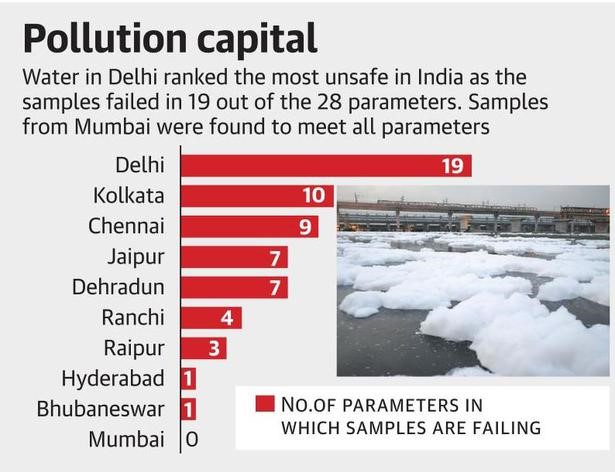Water is one of the most precious, integral and important aspects of almost every living organism. About 3% of the water is fresh water. This fresh water does not contain significant levels of dissolved minerals or salt and two third of that is frozen in ice caps and glaciers and is unavailable for human consumption. In total only about 0.5% of the total water of the planet is accessible for consumption[1]. So, we have a very limited amount of usable fresh water. Now one of the basic human needs is clean drinking water. Unfortunately, more than one in six people still lack reliable access to this precious resource in this developing world[2].
India covers for 2.45% of land area and 4% of water resources of the world but represents 17.7% of the world population. If the population increases with the present population growth-rate of 1.9 % per year then the population is expected to cross the mark of 1.5 billion by 2050. According to the Planning Commission, Government of India water demand will increase from 710 BCM (Billion Cubic Meters) which was in 2010 to about 1180 BCM (Billion Cubic Meters) in 2050. Domestic and industrial water usage is expected to increase by 2.5 times. Increase in urbanization in India is putting a drastic stress on civic authorities to provide basic requirement such as safe drinking water, infrastructure and sanitation[2]. Overpopulation is putting a lot of pressure on available water resources, it is increasing the demand for the portable water, which in turn therefore requires exploration of raw water sources, developing treatment and distribution systems[3]. In this era of rapid growth of population, management, maintenance and monitoring of water and its quality becomes a problem. Therefore, it is important to ensure that the water quality should be maintained at its desired level and should be monitored on regular basis so as to provide safe and quality drinking water.
As our concern is to know the quality of water, so we have gathered some reports across India to understand the recent scenario. We found that many Institutions/Organizations such as Maharashtra Public Health Laboratory, PES university, BIS (Bureau of Indian Standards), Union Government, Jal Sansthan, Ministry of Jal Shakti etc. had worked on checking the quality of water. They checked the quality of water under 28 parameters[4].

Water Treatment Process
Different communities have different procedures of treating the water. Treatment is on the basis of quality of the source water which enters the treatment plant. Now, the water which enters the treatment plant can be from two areas either surface water or ground water. Treatment and filtration are required more in surface water than ground water. This is because streams, rivers and lakes, contain more sediments like clay, sand, silt, soil particles,chemicals,toxins and germs than ground water[7].
The basic purposes of water treatment plant or water treatment process:
- Production of biologically and chemically safe water for human consumption
- Production of water should be appealing to the consumers meaning water should be clear, colourless, pleasant to the taste, odourless, cool, none staining, neither corrosive nor scale forming, and reasonably soft.
- Production of water should be accomplished using facilities with reasonable capital and operating costs[2].
Unit Operations and Unit Process of Water Treatment Units
|
Sl. No. |
Unit Operations and Unit Process |
Principle Applications |
|
1 |
Collection |
Before the treatment, water needs to be collected from various sources such as lakes, ponds, rivers, streams, etc[8]. |
|
2 |
Screening |
Screening is the first step in the treatment process that is needed to remove larger items of suspended materials, such as plants, rubbish, large solid chunks of different materials, plastic packets, trees, animals and other debris[8]. |
|
3 |
Micro strainer |
It is used to remove plankton &algae from water[2]. |
|
4 |
Aeration |
In this process water is supplied with air so as to take up oxygen form air. Aeration helps in making the water less corrosive. it helps in expelling soluble gases such as CO2, H2S and also expels volatile organic compounds. By aeration the taste and odour get improved[9]. |
|
5 |
Mixing |
This process provides rapid& uniform distribution of gases and chemicals into the water[2]. |
|
6 |
Pre-oxidation |
Ozone,potassium permanganate& chlorine, potassium permanganate acts as oxidizing agents in raw water. They retard the microbiological growth and oxidizes the taste, colour and odour causing compounds[2]. |
|
7 |
Coagulation |
Coagulation is the removal of fine particles that are suspended in the water. Rapid mixing of coagulant (positive charge) is done in this method resulting in neutralization with the negative charged particles. Lastly, fine particles come together to form flocs. Aluminium sulphate, ferric chloride, etc are the coagulants used in this process[9]. |
|
8 |
Flocculation |
Flocculation isthe process where water is gently mixed in a flocculation tankto form larger and heavier flocs [7]. |
|
9 |
Sedimentation |
For sedimentation process a settling tank is used in which the large flocs that are formed in the previous process will fall because of gravity and settle on the floor of this tank[9]. |
|
10 |
Filtration |
Filtration removes dust, parasites, germs, dissolved particles, etc from the water. In this process the clear water that is above the settling tank is passed through filters with different pore sizes and are made up of different materials such as sand, gravel, charcoal, etc., [7] |
|
11 |
Disinfection |
This process is needed to destroy thedisease-causing organisms in water. Disinfection is done by oxidative chemicals such as bromine, chlorine, iodine, ozone &potassium permanganate, and also the ultraviolet radiation helps in disinfection[2]. |
- https://www.usbr.gov/mp/arwec/water-facts-ww-water-sup.html
- https://cpcb.nic.in/openpdffile.php?id=UmVwb3J0RmlsZXMvTmV3SXRlbV8xMDNfc3RhdHVzb2Z3YXRlcnF1YWxpdHlwYWNrYWdlLnBkZg==
- http://fubini.swarthmore.edu/~ENVS2/dan/Essay4.html
- https://www.thehindu.com/news/national/only-mumbai-meets-drinking-water-quality-standards/article29992150.ece
- https://www.intechopen.com/chapters/69568
- https://www.ajol.info/index.php/gjes/article/view/50824#:~:text=The%20WQI%20values%20for%20the,values%20were%20less%20than%2070.
- https://www.cdc.gov/healthywater/drinking/public/water_treatment.html
Visited 1562 times, 2 Visits today


